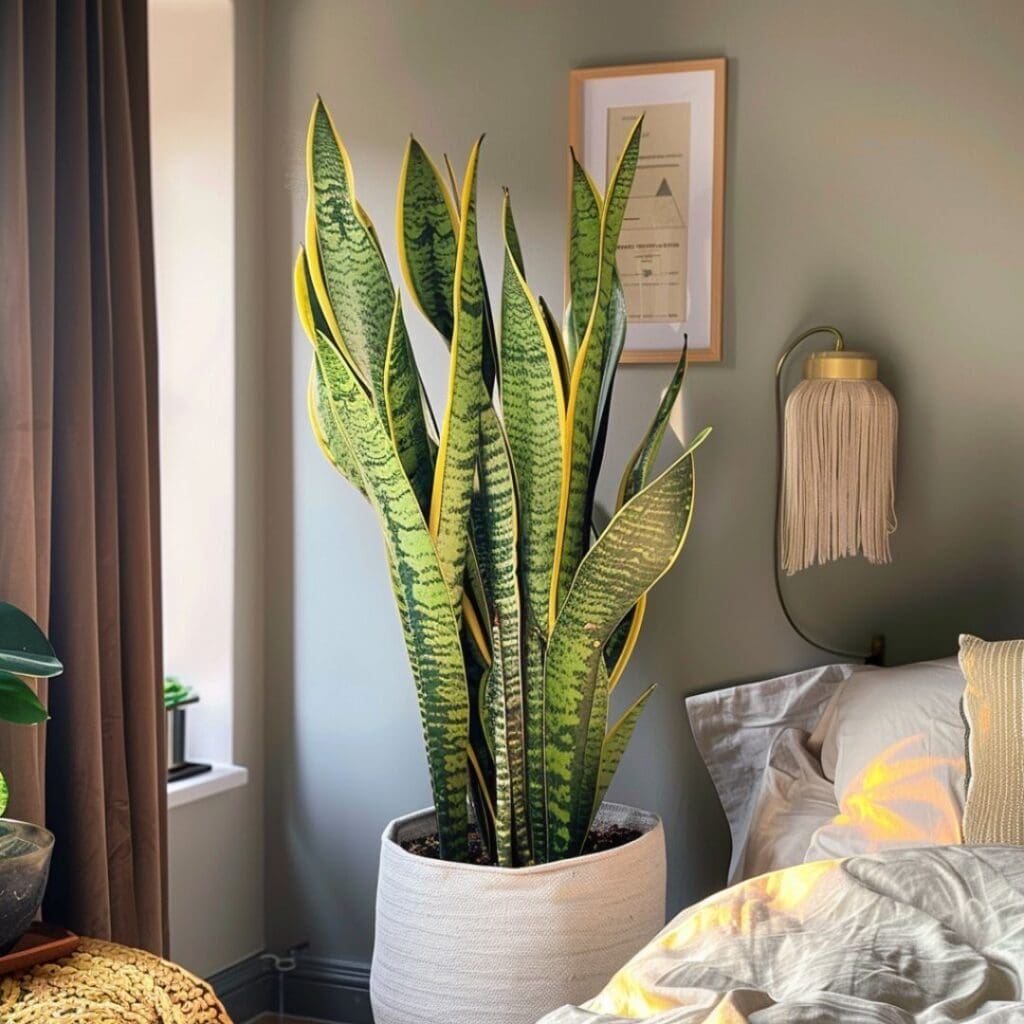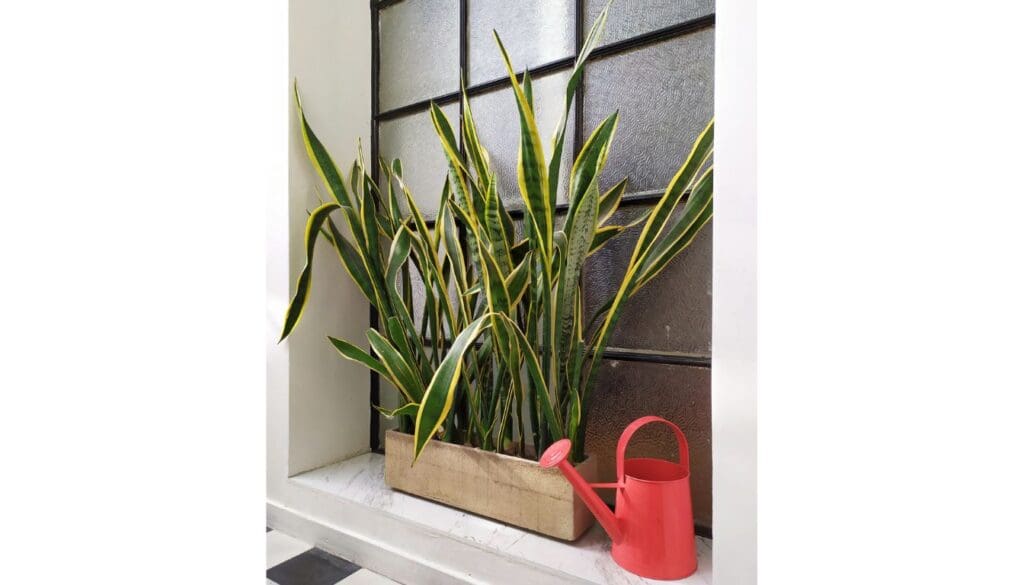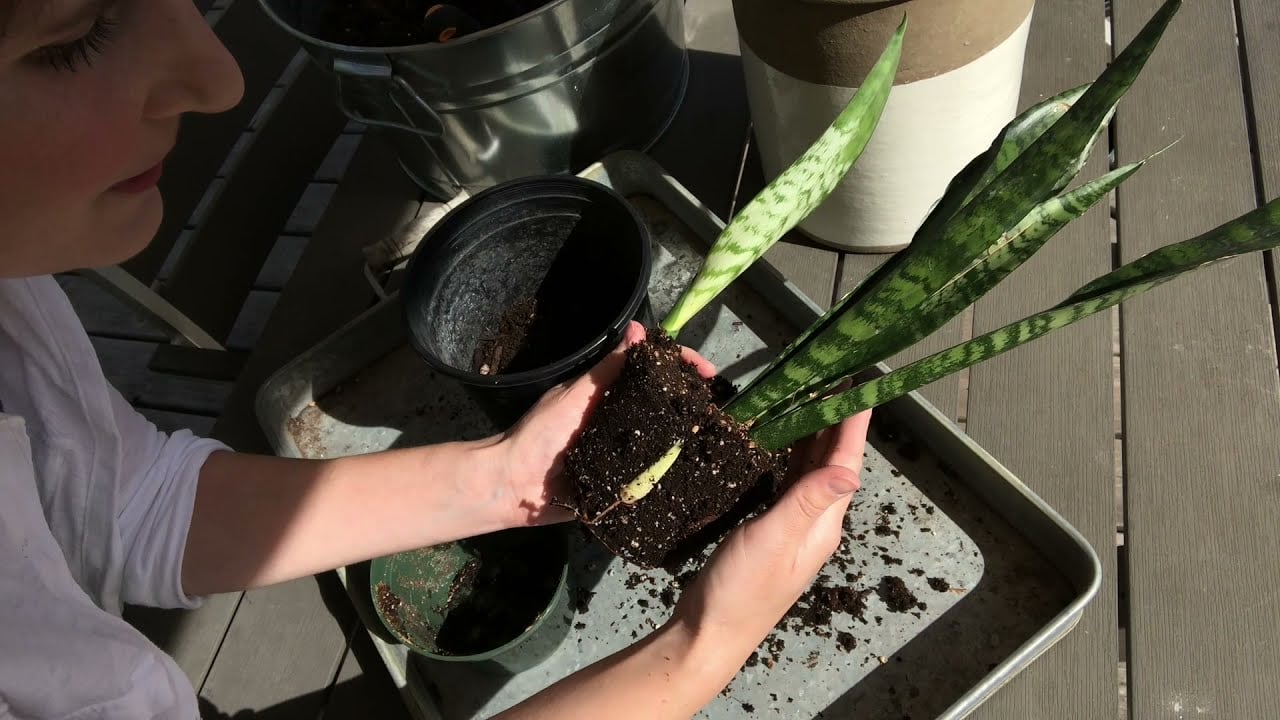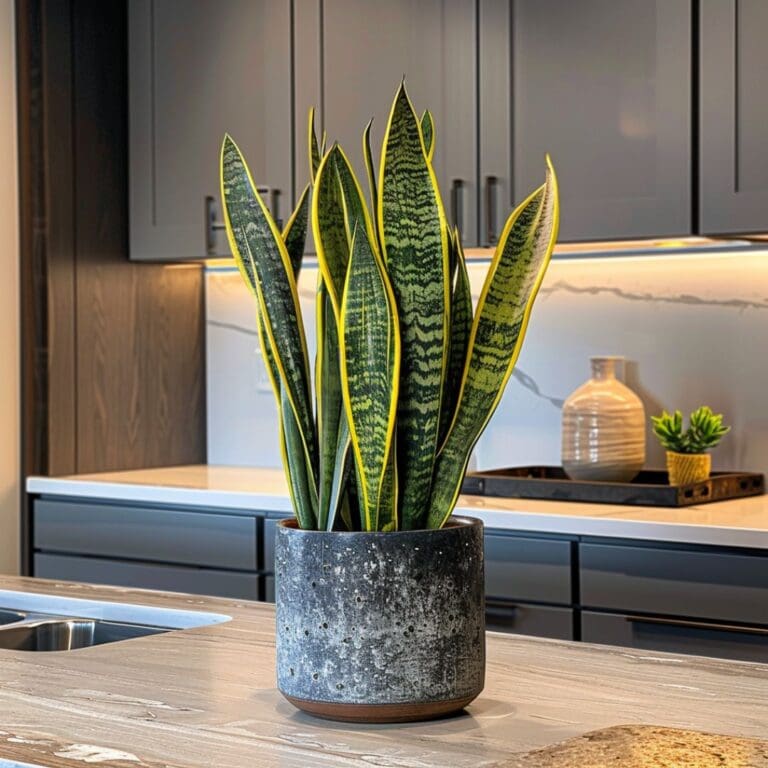How To Get Your Snake Plant to Grow Straight?
I love snake plants! They’re one of my favorite houseplants because they’re hardy and look great. But sometimes their leaves might start leaning or flopping over, and that’s not as nice.
To keep your snake plant growing straight, you need to give it enough light and rotate it regularly.
You’ve probably noticed how plants always lean towards the light. It’s like they’re sunbathing!
Try moving your snake plant to a spot where it gets some bright, indirect light. Do you ever try moving closer to the sun just to get a tan? 🌞 That’s exactly how your plant feels!
Another tip is to give your plant a little spin.
I like to rotate my snake plant every time I water it. That way, each side gets equal exposure to light.
Have you ever spun around just to balance yourself out? Your plant needs that too! 😄

Please note: Simplify Plants is reader-supported. As an Amazon Associate, I earn from qualifying purchases made by our readers with no extra cost added to you all! Some links in the post are affiliate links and I get a commission from purchases made through links in the post.
Understanding Your Snake Plant
Let me tell you about my favorite houseplant, the snake plant! It’s bold, tall, and oh-so-easy to care for. 🌿 You might even have one sitting proudly in your living room right now.
Snake plants, also known as Sansevierias, are famous for being hardy and low-maintenance. I can forget to water mine for weeks, and it’s still happy! Does your plant put up with your forgetfulness too? 😉
The leaves are the stars of the show—tall and sword-like, reaching for the sky. If they start to flop, don’t panic! It might mean they’re craving some light or support.
A few things to check on:
- Light: They do well in low light, but bright, indirect light makes them stand tall.
- Water: Allow the soil to dry out between waterings. They hate soggy feet!
Snake plants are also known as Mother-in-law’s tongue. Ever wondered why? Perhaps it’s due to their sharp, pointy leaves!
Did you know they’re also air-purifying champions? They help clean the air, making your home a healthier place.
Feel free to give your snake plant a name—I call mine Spike! Do you have a quirky name for yours too? 🐍
Happy growing, plant lovers! Enjoy watching your green buddy thrive. 💚
Optimal Growing Conditions
To help your snake plant grow straight, it’s essential to create the best environment. Think about light, soil, water, temperature, and humidity for the healthiest growth. Each aspect plays a role, and I’ll walk you through it. 🌿
Light Requirements
I discovered that snake plants love bright, indirect light. Placing them near a window with filtered light works wonders. 🌞
If you notice the leaves bending or tilting, it might be a sign to adjust their light source.
Direct sunlight can scorch the leaves, so I avoid hotspot windows. They can survive low light, but growth won’t be as straight or quick.
Imagine them reaching up like me when I try to catch something high up—and missing! 😂
Soil and Pot Selection
For soil, I use a well-draining mix, like cactus or succulent potting soil. It’s perfect for avoiding root rot, which these plants are prone to. Good drainage is key.
As for pots, choose one with drainage holes.
I’ve learned through trial and error that the pot size matters too. A tight fit stunts growth, while too large encourages waterlogging.
Think of it like wearing shoes: just the right fit makes all the difference! 👟
Watering Techniques

I water my snake plant every two to six weeks, depending on the season. It’s crucial to let the soil dry out between waterings. Overwatering leads to mushy leaves or root issues.
I often poke my finger into the soil (a simple moisture test). If it’s dry, it’s time for a drink.
Once in a while, do you find yourself being overly generous with water? I learned the hard way that less is more with these babies. 🌱
Temperature and Humidity
Snake plants thrive in a range of 60-80°F and are pretty easygoing with humidity levels.
My home is often around these temperatures, which makes my plant happy. Too cold can damage them, so keep them away from drafty windows or doors in winter.
I avoid high humidity spots like bathrooms or kitchens as constant moisture isn’t ideal.
Picture me imagining what my snake plant would say: “I love warmth, but I’m not a fan of steamy saunas!” 🧖♀️
Planting and Repotting

Getting your snake plant to grow straight requires proper planting and repotting. I’ll share some tips on choosing the right container, the planting process, and knowing when to repot. These steps will help your plant flourish. 🌱😊
Choosing the Right Container
Picking the right pot is key! It needs to have good drainage so your snake plant doesn’t get soggy roots.
Clay or terracotta pots are great because they let water escape easily. Have you ever seen root rot? It’s not pretty!
Consider the size, too. A pot that’s about 1-2 inches wider than the plant’s root ball is ideal so it has room to grow but isn’t lost in a giant container.
You’ll want your plant to feel cozy, not cramped or floating!
The Planting Process
Ready to plant? Start with a good potting mix. I use a well-draining soil mixture. A cacti or succulent mix works well. 🪴 This helps avoid any waterlogging.
Gently place the snake plant into its new home. Make sure it’s centered and upright.
Press the soil down firmly but avoid packing it too tight. This supports the plant as it grows straight and tall.
Not too hard, not too soft—think Goldilocks!
When To Repot
Snake plants need repotting every 2 to 3 years.
Look for signs like roots peeking out of the drainage holes or the plant becoming top-heavy.
Is your snake plant tipping over? That’s a clear sign it’s time!
Spring is the best season for repotting since the plant naturally grows more during this time. Fresh soil and a slightly larger pot give it space to thrive.
Keep an eye on it and feel proud when it stands tall and strong! 🏆
Do you have any tips or tricks for keeping plants straight? Let’s chat in the comments! 🌿✨
Routine Care and Maintenance

Taking care of a snake plant means keeping it neat, nourished, and healthy. It’s pretty simple, and with a little effort, your plant will thrive. Let’s get into some of the basics.
Pruning and Grooming
Pruning is like giving your plant a haircut! 🤔 Seriously, it’s pretty straightforward.
I take off the old, yellowed leaves to help it grow strong and straight.
It’s good to use clean, sharp scissors to avoid harming the plant. Sometimes, I find dust on the leaves, so I just wipe it with a damp cloth.
Simple grooming can keep the plant looking its best. Is your snake plant starting to lean or look a little wild? Give it a trim!
Feeding and Fertilizers
Feeding my snake plant is easy, just like tossing a handful of food its way. 😄
I usually fertilize once every two months. A balanced liquid fertilizer works best.
Be careful, though. Too much fertilizer can hurt instead of help.
It’s like giving it too much candy! A small amount during the growing season—spring and summer—keeps it happy.
If you’re not sure, less is more here. I keep my plant healthy, and it thanks me by staying strong.
Pest and Disease Management
Don’t you just hate unexpected guests, like pests? My snake plant feels the same! 😆
Mealybugs and spider mites are common culprits that attack. I usually spot these little pests on the leaves.
To deal with this, I use soft cloths soaked in soapy water to gently clean them off.
Checking your plant regularly keeps these problems small. Yellow spots aren’t just an annoyance—they can mean something’s wrong.
I make sure diseases aren’t lurking by examining the leaves every now and then.
Proper care keeps my plant healthy and happy. If I can do it, so can you! 🌿
Supporting Straight Growth

Getting your snake plant to grow upright can be tricky, but it’s totally doable with a few handy tips. I’ll share how using stakes, rotation, and correcting any leaning can keep your snake plant standing tall and proud. Let’s dive in and see how we can make your plant the star of the room! 🌿
Staking
Sometimes snake plants need a little help standing straight. I use stakes to give them that boost.
You can easily use a bamboo stick or a garden stake. Anchor it into the soil near the plant’s base.
Tie the plant gently to the stake using cloth or plant ties. Make sure it’s secure, but not too tight.
The idea is to support it, not squeeze it. 😂 Just like how we sometimes need a hand from friends! 🌱
Keeping an eye on the plant is crucial.
Adjust the ties as your plant grows, allowing it to naturally stand upright without relying too heavily on the stake. Over time, they’ll grow stronger and sturdier.
Rotating the Plant
Plants love a good spin! By rotating your snake plant every week or two, you help all sides get equal sunlight. This prevents it from leaning towards the light source.
Place it in a spot with indirect light that reaches all sides.
It’s like making sure your plant gets a workout for all its leaves. 💪🌿 Do you remember to turn it?
When you see new growth, you know it’s working. Keep the rotation consistent, and your plant will thank you by growing straight up.
Correcting Leaning
What if you notice your plant leaning? Don’t worry!
First, check if it’s in a spot with uneven light. If it is, try moving it to a place where it can get light evenly.
Next, place a stake for temporary support.
Give it a gentle nudge to straighten it, but be careful not to damage the roots.
Sometimes, a simple repotting can fix the slant. Repot the plant, setting it straight and firm in its new pot.
Voila! Watch it perk up over the next few weeks. 🌿✨ Have you tried giving your plants a little extra love this way?
Troubleshooting Common Issues

Let’s explore some common problems that can affect your snake plant’s growth. With a few simple fixes, you can help your plant thrive. 🌿
Curled Leaves
I’ve noticed that snake plant leaves can curl for several reasons.
One cause is underwatering. When the soil gets too dry, the plant tries to preserve water, causing the leaves to curl.
I recommend keeping the soil slightly moist and checking it regularly.
Too much sun can also make leaves curl.
If your plant is getting too much direct sunlight, consider moving it to a spot with indirect light. This helps prevent stress on the leaves.
Sometimes, temperature changes can also be a problem.
Keep the plant away from cold drafts or hot radiators. It prefers a steady, warm environment. 🏡
Brown Tips and Spots
If you see brown tips or spots, it might be due to inconsistent watering.
I make sure to water my plant when the top inch of soil feels dry. This prevents over or underwatering.
Dry air can also be a culprit.
Snake plants enjoy humidity, so consider placing a small humidifier nearby. Alternatively, misting the leaves lightly can help, too.
Check the fertilizer! Using one with too much salt content causes spotting.
I opt for a balanced houseplant fertilizer and follow the instructions. This keeps those pesky brown tips away and my plant looking fresh. 🍃
Slow Growth
Notice your snake plant growing slower than expected?
Low light levels might be the issue.
I try positioning mine nearer to bright, indirect sunlight. This speeds up growth without harming the plant.
Nutrient deficiency can also slow things down.
I feed my snake plant every couple of months with a well-balanced fertilizer during the growing season. This gives it the boost it needs to thrive.
Lastly, overwatering can stunt growth.
The roots suffer if they stay soggy too long.
I avoid this by ensuring the pot has good drainage and that I only water when needed. 🌱
Propagation Techniques

Ever thought about growing more snake plants at home? You’re in luck! I’m sharing my favorite methods to multiply these green beauties. 🚀 Let’s dive in!
Division Method
I find the division method super simple and effective.
This technique involves splitting a mature plant into smaller sections, each with its own roots.
First, I carefully remove the plant from the pot. The soil might be a little clingy, so I gently shake it off.
Once the roots are visible, I use a clean knife to slice between them. I aim to keep some roots attached to each section.
After I’ve divided them, it’s essential to plant each section in its own pot filled with fresh soil.
I water them lightly to help settle the roots.
This method might make you a bit nervous at first, but it’s worth it. 🌿 Don’t you think watching new plants grow is exciting?
Leaf Cutting Method
The leaf cutting method is another fun way to propagate!
I pick a healthy, mature leaf and cut it off near the base. Each leaf can be divided into several pieces, usually 3-4 inches long.
Before planting, I let the cuttings dry out for a day or two. This helps prevent rot.
Then, I plant the cuttings a few inches deep in a pot with well-draining soil.
I water them sparingly, making sure they get just enough moisture to thrive.
New roots and little baby plants usually start to form in a few weeks. How cool is it that one leaf can lead to a whole new plant? 💚
Decorative Tips for Displaying
Ever thought about sprucing up your snake plant display? Let’s get creative! 🌿
I love pairing my snake plant with cool, colorful pots. Using terra cotta or ceramic pots adds a nice touch.
How about placing it in a hanging basket by the window? It’s an eye-catching choice!
Think a grouping method is fun.
I often place my plant with others of different sizes for a lively corner.
Do you have an old stool or a stack of books? Elevate your snake plant for a chic look. 📚
I also play with heights.
Using a plant stand can take your snake plant to new levels.
Have you tried using different stands for a layered effect? It’s a game-changer. Trust me.
Lighting plays a huge role in display aesthetics.
Positioning your plant where it can soak in just the right amount of light will make colors pop.
Sunlight can bring out the best, too much is not fun, though. 😅
Do you prefer a minimalist approach? A simple white pot can really highlight the plant’s elegance. Just a classic combo.
Do any of these ideas spark your interest? I’d love to hear about your favorite display tricks! Drop a comment or snap a pic and share with us! 📸✨
Frequently Asked Questions
Have you ever had trouble with your snake plant leaning or looking out of shape? No worries! I’m here to help get those leaves standing tall and strong. 🌱 Let’s dive into some common questions you might have.
Why do snake plant leaves sometimes fall over, and how can you fix that?
Snake plant leaves fall over from lack of light, too much water, or weak roots.
I try adjusting the light level in my home and cut back on watering. A gentle stake for support helps too.
What methods are there to support a snake plant to encourage upright growth?
I use small stakes or support rings when my snake plant looks floppy.
Adding more light and checking the soil helps boost its growth. Trust me, small changes can make a big difference! 💪
Is it okay to cut drooping leaves off of a snake plant?
Yes, it’s perfectly fine to trim drooping leaves.
Cut them at the base of the plant. This encourages new growth, and keeps my plant looking neat and tidy. ✂️
What causes a snake plant to grow sideways and how can you correct it?
Sideways growth often means my snake plant wants more light or space.
Rotating my plant and placing it in a sunnier spot did wonders. It’s a simple trick, and it works like magic! 🌞
How can you straighten a snake plant that is leaning?
Gently repositioning and using stakes to prop my plant up usually works.
I also reassess the lighting in the room to ensure it’s getting even sun exposure. It’s like giving it a gentle nudge in the right direction! 😊
What steps are involved in propagating a snake plant?
For propagating, I use a healthy leaf and cut it into sections. Place these in water until roots appear, then plant in soil.
It’s an exciting way to multiply my green friends!
Note: Some images in the articles are sourced from Reddit and Other Platforms For Reference Purpose.







